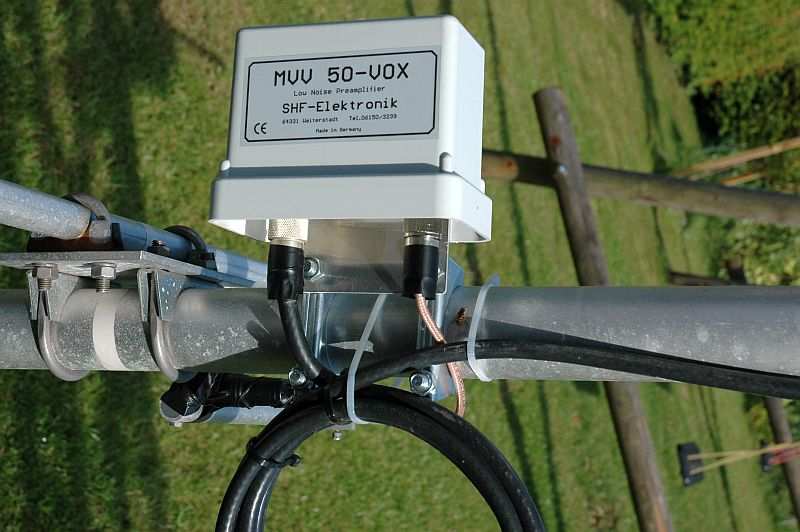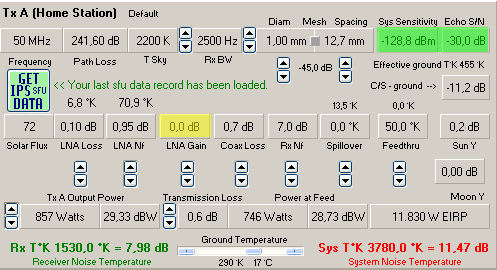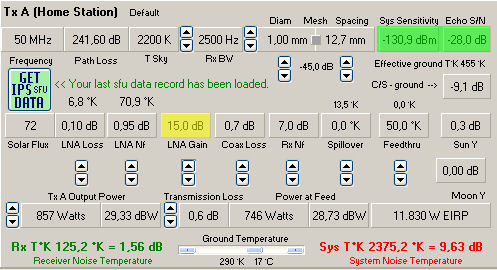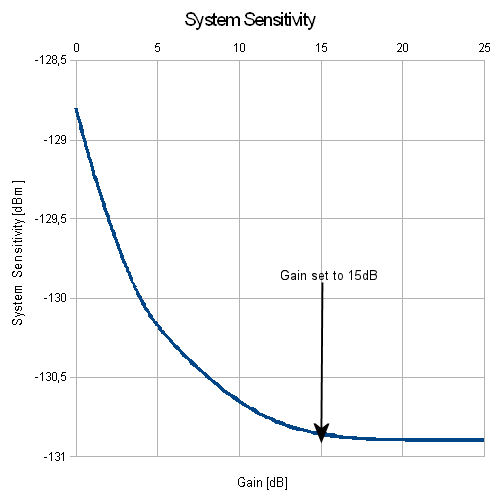© Christoph Petermann DF9CY 2009
Last Revision: 07 August2009
Intention
In Summer 2009 I decided to invest into a preamplifier for 50 MHz to install right at the feedpoint of the antenna. It is more or less an experiment, as background noise on 6m is already that high, that this may give me no advantage at all.
Now after installation and some publication on my webpage and in forums, I received a number of mails concerning the "sense" of my action ... This made me re-think and calculate some stuff.
The 50 MHz Preamplifier
In August 2009 I have mounted a 50 MHz preamplifier at the antenna feedpoint. In this case I chose a commercial preamplifier from SHF-Elektronik in Germany. It is very robust and uses a MOSFET BF980 which has low noise figure, good gain and a good large signal performance.
I took the amplifier to my workplace and measured noise figure and gain with a HP8970B noise figure meter. I have set gain to about 15 dB (this can be set with a potentiometer) and this resulted in a noise figure of 0,95 dB. Raising gain to 22 dB lets improve noise figure to 0,8 dB and setting gain to 10 dB increases noise figure to 1,2 dB. Insertion loss measures with the HP8970B 0,12 dB - with Rohde & Schwarz ZVC vector network analyser I see 0,10 dB.

The 50 MHz Preamplifier mounted at the feedpoint of the 6 element
yagi. Connecting cable ca 30cm of low loss RG400 teflon cable.
Connectors are N-type and the main feedline is H2000 Flex low-loss
cable.
The Transceiver Kenwood TS690s
I own this Kenwood TS690s a very long time now - since 1991. It always worked fine and never gave me a reason for trouble. Some years ago, when working at a different company, I measured its performance and calculated the receiver noise figure for 50,1 MHz. I have done this by determining the 20dB S/(S+N) signal/noise ratio. At that time I calculated the overall noise figure to be exactly 7,0 dB, which is not bad for such a machine. I do not believe, that this value has changed trough the last 5 years. This figure went into the system calculation.
First Impression
When I first time switched ON the preamplifier, the 50 MHz band sounded to be more "rough"; I mean I felt to hear the "white-noise" not more to be so smooth ... With very weak signal, backscatter for example, I have the impression they are barely better readable. I mean: I have the impression ! I did not receive EME signals so far, but I know the signal strengths of W7GJ and W1JJ, and I will try to receive as soon as possible.
Measuring Weak Signals
Of course I want to see if this impression of a slight improvement is reality or not. I often use SpectraLab by DL4YHF for these purposes and my ultra-low noise sound card (EMU0202). This is permanently attached to my TS690s transceiver.
I turned the antenna into a direction where noise is lowest and where no galactic noise source was just "hanging around". A very weak signal is found easily with all those sources nowadays in every household. I have built a little signal source with an adjustable output around a few microwatts. This source I could hang about 300m away into a tree. It is so small, that nobody can see it. It has a battery which will run for days. If I adjust output while standing just 9m below the antenna until it is barely audible, it still may be strong 300m away. This method works fine for me.
I set the program to average that signal in spectrum mode over 10 samples to reduce some of the noise. I measure the signal first with preamplifier OFF and then after switching ON I have to readjust the noise floor to the same setting. With the EMU0202 soundcard this is done manually by a potentiometer, which allows very fine setting. Then the signal is to be remeasured. Any difference is visible at once.
... Graphs to follow ...
Calculation
I prefer to use the VK3UM EME system calculator. Results are similar to my own EXCEL sheet or the calculator in my AURIGA software package. The VK3UM calculator has some more parameter, which can be modified, especially those concerning background noise.
I have set the parameters I see in the images below and have a look on the system sensitivity (and/or own echo) how it changes if I tune the gain of the preamplifier. All other station parameters are given fixed.
Finally I end in putting the results into a graph, which shows the improvement of system sensitivity in my special case. I have set the amplifiers gain to 15 dB. The transceivers noise figure is supposed to be 7 dB. This results in an improvement of 2 dB. And that is about that what I see.

Preamplifier OFF = no gain (gain marked YELLOW / Result marked
GREEN)

Gain set to 15 dB / all other parameters unchanged.

System sensitivity over gain variation. I could get 0,2 dB more by
using 25 dB of gain, but this is completely not necessary.
Conclusion
The improvement IS marginal, but well worth for EME (moonbounce) reception. The amplifier will stay at the antenna over the winter time and I will make more tests with it.